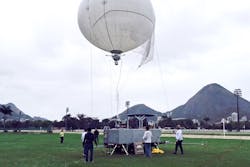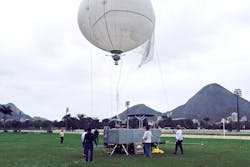Simera wide-area motion imagery sensor on aerostat to help secure Brazil Olympics
FAIRFAX, Va., 24 Feb. 2016. Officials in the Brazilian Ministry of Justice sought an effective, airborne security asset for the 2016 Olympics in Rio de Janeiro, from 5 August through 21 August 2016. They found their solution at Logos Technologies LLC, a science, engineering, and technology company specializing in advanced sensors, wide-area motion imagery (WAMI, also known as persistent surveillance), advanced analytics, and processing of large, multi-source datasets, in Fairfax, Virginia.
Brazilian Ministry of Justice officials are deploying Logos Technologies’ Simera exportable wide-area sensor as part of their security solution for the 2016 Olympics, which will mark the first time a non-U.S. government entity has operated a WAMI sensor at an international sporting event, officials say.
“Until now, WAMI sensors have been used either to protect U.S. troops in Iraq and Afghanistan or have been tested for domestic law enforcement and border security,” says John Marion, president of Logos Technologies. “This will be the first time that this sophisticated technology has been exported abroad.”
Related: Aerostat systems market to nearly triple to $9.96 billion by 2020
In late 2014, the Brazilian Ministry of Justice put out a request for proposals (RFP) from local industry for methods to help secure the upcoming Olympics. A few months later, the government selected and finalized negotiations on a package of solutions offered by ALTAVE, a Brazilian lighter-than-air aerospace company. The key sensor technology in the ALTAVE proposal was Simera.
“Simera weighs fewer than 40 pounds (18 kilograms), so it is light enough to go on a wide variety of aerostats, or tethered blimps,” describes Deborah Althoff, Simera program manager. “In this case, the platform is the Altave Omni system.”
Logos engineers worked with Altave to integrate Simera into their security solution for the Olympics. Brazilian Ministry of Justice staff performed rigorous testing and accepted the assets.
Simera is based on the battle-proven Kestrel system, developed by Logos Technologies and deployed on large aerostats at U.S. forward operating bases (FOBs) in Afghanistan beginning in 2011. Kestrel operates both day and night, and gives the operator a 360-degree field of view of a city-sized area.
Like Kestrel, the new Simera exportable, electro-optical WAMI sensor can monitor city-sized areas in near real-time as well as provide operators a complete video recording of events on the ground for later analysis.
In addition to major sporting and other large events, Simera can be used to safeguard borders, ports, railways, and logistics hubs. This new WAMI sensor also can be rapidly deployed on small, tactical aerostats to support humanitarian assistance and disaster relief missions.
“The entire system, aerostat and sensor, can be carried in two small trailers, and can go from packaged to fully operational system in just two hours,” Althoff says.
Founded in 1996, Logos Technologies LLC is a diversified science, engineering, and technology company specializing in the fields of advanced sensors, wide area motion imagery, cyber operations, advanced analytics and processing of large, multisource datasets. Logos serves government customers including the Department of Defense, Department of Energy and Department of Homeland Security, as well as a range of customers in commercial and international markets.
You might also like:
Subscribe today to receive all the latest aerospace technology and engineering news, delivered directly to your e-mail inbox twice a week (Tuesdays and Thursdays). Sign upfor your free subscription to the Intelligent Inbox e-newsletter at http://www.intelligent-aerospace.com/subscribe.html.
Connect with Intelligent Aerospace on social media: Twitter (@IntelligentAero), LinkedIn,Google+, and Instagram.
Intelligent Aerospace
Global Aerospace Technology NetworkIntelligent Aerospace, the global aerospace technology network, reports on the latest tools, technologies, and trends of vital importance to aerospace professionals involved in air traffic control, airport operations, satellites and space, and commercial and military avionics on fixed-wing, rotor-wing, and unmanned aircraft throughout the world.



